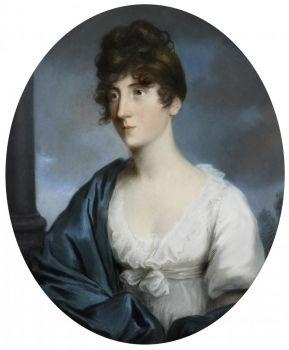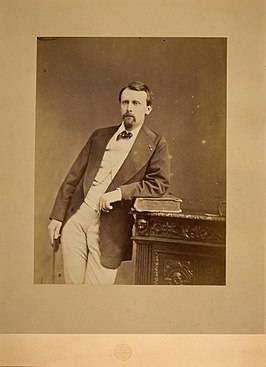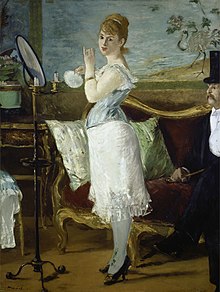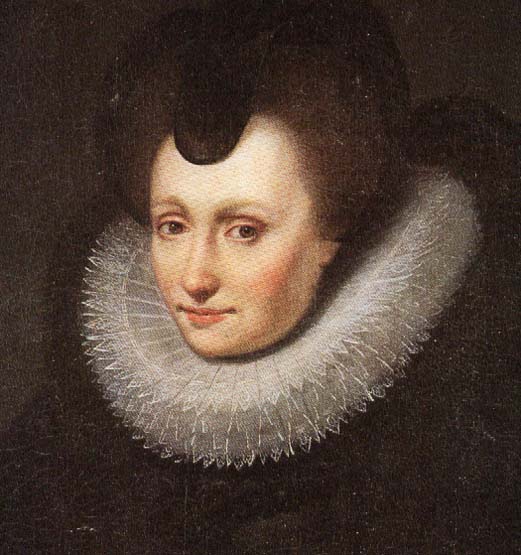 |
| Willem I of the Netherlands |
(1772-1843)
King of the Netherlands &
Grand Duke of Luxemburg
1815-1843
Son of: Willem V van Oranje, Stadtholder of Dutch Republic & Wilhelmine von Preussen.
Husband of:
1. Wilhelmine von Preussen (1774-1837)
2. Henriette d'Oultremont de Wegimont (1792-1864)
Countess of Nassau.
"Henriette d'Oultremont did not belong to the ladies of the battle of Madame de Pompadour or other mistresses with a debauched lifestyle. She was an honest and deeply religious woman who fitted with the court life of King William I in Brussels and The Hague, which went on for the dullest of Europe. Spurred on by family and politics, and laughed at by press and public opinion, William I and his second wife, a Catholic countess from the newly-torn Belgium, found comfort and love together until death separated them. Pure passion and romance so ... The marriage proposal, in May 1839, came totally unexpected. Willem was 67 years and widowed for less than two years; she was 47 years old, unmarried and already 22 years old lady-in-waiting. According to the prevailing standards, it was not known as a beauty; she was tall and thin. She did enjoy the sympathy of everyone because of her 'cheerful character, grace and tactful appearance'. She was sharp-minded, eloquent, full of temperament and esprit. And not without ambitions, some thought. Henriette d'Oultremont was also Catholic, not princely and from the newly independent Belgium, the three main objections to a possible marriage. The latter reproach was partly unjustified. Henriette was born in 1792 in Maastricht, more specifically in a house that belonged to the Servaasgasthuis near the Vrijthof. Her mother was a daughter of Admiral Hartsinck. The counted family d'Oultremont played a leading role in the prince bishopric of Liège and had integrated into the Northern Dutch elite. Her father fought with the Dutch guards against the French revolutionaries; her two brothers brought it to chamberlain of Willem I and Prince Frederick, respectively." (Geschiedenis)
 |
| Julie von der Goltz @MutualArt |
His lovers were:
1) Julie von der Goltz (1780-1841)
Lady in Waiting to the Queen
Daughter of: Karl Franz von der Goltz & Henriette Wilhelmine Barmann.
Natural offspring:
1. Wilhelmine Marie von Dietz (1807-?)
2. Wilhelm Ernst Ruprecht von Dietz (1809-?)
3. Wilhelm Friedrich Timotheus von Dietz (1810-?)
4. Wilhelmine Marie von Dietz (1812-1836) mar 1829 Karl von Jasmund (1806-1859)
Personal & family background.
"The father of Julie von der Goltz came from an old noble family whose members for centuries as an officer served the Electors of Brandenburg, respectively, the Kings of Prussia. The family owned large estates, including Heinrichsdorf. The father was an officer. He left for financial reasons ?? ?? the service and became a minor nephew, manager of Heinrichsdorf. When the cousin's estate later sold, bought father Von der Goltz, with the support of an inheritance, the estate Langhof. Soon he sold the estate and became an officer in the service of the Kingdom of Prussia. The family moved to Berlin. That family was born in 1780 Julie, second daughter. In 1804 passed both her father and her older sister Henriette Wilhelmine, and that same year married the younger sister Karoline Ernestine.Julie was left alone with her mother. She was employed as a maid of honor of the Queen of Prussia." (Feeling Keep: All Knowledge in One Place)
"She later became governess to Princess Pauline daughter of Crown Prince Frederick William of Orange-Nassau. Willem Frederik and his wife Wilhelmina ?? a sister of the Prussian King ?? and their children were staying at the time in Berlin. Toen approached Napoleon's armies Berlin, Wilhelmina and left the children and Julie von der Goltz towards Konigsberg. Pauline died en route. Julie stayed with the royal family and was afterwards honor of Mimi." (FeelingKeep: All Knowledge in One Place)
2. Maria Dorothea Hoffman.
Lover in 1807-1812.
 |
| Willem I of the Netherlands |
J. Koch writes in his book on King William I that, in the period between the autumn of 1807 and the summer of 1812, as crown prince of Orange four times became a father of children who were conceived by a woman in the baptismal register ' Maria Dorothea Hoffman ?? is called. The oldest of the children, Wilhelmine Marie, was born on October 1, 1807. This was followed in 1809 respectively in 1810, two sons and a daughter in 1812. That second daughter was called again Wilhelmine Marie ?? suggesting that the eldest daughter was now deceased. The children were baptized in the Reformed Church in Berlin; in the baptismal register of the church they are registered as children of Wilhelm Friedrich von Dietz and Maria Dorothea Hoffmann. They were given the surname von Dietz. That was one of the titles that William Frederick had inherited from his father. At baptism performed among others two brothers of the Prussian King and William Frederick aide, Robert Fagel, as a witness. Koch therefore no doubt that these Friedrich Wilhelm von Dietz was actually Crown Prince Frederick William of Orange-Nassau. This is partly based on the account of the baptism of the first child, Robert Fagel subsequently made to the mother of William Frederick, the widow of William V, Princess Wilhelmina of Prussia." (FeelingKeep: All Knowledge in One Place)
 |
| William II of the Netherlands @Royal Collection Trust |
(1792-1849)
King of the Netherlands
Grand Duke of Luxemburg
& Duke of Limburg
1840-1849
 |
| Willem II & his family |
"William II’s love life was quite controversial. He was said to be involved with numerous women. And men. His first engagement failed courtesy of long-distance relationship challenges- William II got engaged to Princess Charlotte of Wales in 1814, but this was broken off due to the Princess’ mother disapproval, as well as Charlotte’s reluctance to relocate to the Netherlands." (5 Famous Dutch Kings @Discover Walks)
His lovers were:
1) Dorothea van Dijck.
2) Keetje van Raamsdonk.
3) Marianne von Evers van Aldenriel.
4) Susanna Diehl.
Natural offspring:
Willem Joseph Andries Jonckbloet (1817-1885)
"Willem Joseph Andries Jonckbloet was born in The Hague on 6 July 1817. His birth certificate names his parents as Johannes Jonckbloet and Susanna Diehl, both of whom were in service at the Royal Court. However, as Wim Gerritsen has argued, there are strong indications that he was actually the illegitimate son of King Willem I: either way, he was a young man of remarkable talents who acquired his doctorate at the age of 23 and enjoyed government support for his work on the editio princeps of Le Chevalier de la Charette ou Lancelot [The Knight of the Cart or Lancelot]. . . ." (Martin. Travel Writing in Dutch and German, 1790-1930: Modernity, Regionality, Mobility: 184)
.jpg) |
| Willem III of the Netherlands |
(1817-1890)
King of the Netherlands
Grand Duke of Luxemburg
& Duke of Limburg
1849-1866
Willem III's physical appearance & personal qualities.
"The King was a man of immense stature and with a boisterous voice. He could be gentle and kind, then suddenly he could become intimidating and even violent. He kicked and hit his servants about. He was inclined to terrorize and humiliate his courtiers. The King was cruel to animals as well. His ministers were afraid of him. Most people around him agreed that he was, to some degree, insane. The King could be erratic, he ordered the dismissal and even the arrest and execution of those that he found in lack of respect, including a Mayor of The Hague. . . ." (Amazing Holland)
Husband of:
1. Sophie von Wurttemberg, mar 1839-1877.
"That William III should have combined so many peculiar traits, prompting every species of vagary, is principally due to his ancestry on the maternal side. His mother was a daughter of the Emperor Paul of Russia, one of the most dissolute monarchs in Europe. The Dutch king’s waywardness antedates his accession to the throne in 1849, for it is current talk among the Dutch that when the prime minister, after William II’s death, went in search of the new sovereign, then absent abroad, he found him after much difficulty traveling incognito with a French singer among the Highlands of Scotland. His married life, at least that portion of it which he passed with his first wife, a daughter of the king of Wurttemberg, was not a happy one to either husband or wife. The latter was an amiable and gifted woman, but too much of a blue stocking to suit her pleasure loving lord. She gave up trying to reform him and sought consolation in the society of artists and men and women of letters. Her friendship for John Lathrop Motley, American minister at The Hague and author of the “Rise and Fall of the Dutch Republic,” was one of the rays of sunshine in the life of that great writer." (Mrs Daffodil Digresses)
2. Emma von Waldeck und Pyrmont, mar 1879.
2. Emma von Waldeck und Pyrmont, mar 1879.
"It is the poverty of the family that has been accountable for some of the strange marriages of the princesses, notably that of Princess Emma, when 21 years of age, to the wicked, repulsive looking and frightfully dissipated old King William III of the Netherlands, who was 63 but who looked at least ten years older. Her married life was not happy, owing to his frightful irascibility, and her situation was rendered absolutely intolerable, when, a year before his actual demise, he fell into a cataleptic trance, was proclaimed dead and then came to life again, with all his wits about him, to find that she had donned widow’s weeds and had assumed the reins of government as regent. Kansas City [MO] Star 20 October 1918: p. 1." (Mrs Daffodil Digresses)
"Queen Wilhelmina’s mother was married at twenty to a brutal, selfish old widower, King William III of the Netherlands. People said that later, when she went every day to pray over his coffin, she did so to convince herself that he was really dead. Yet—so history repeats itself—Queen Emma married off Wilhelmina in her teens to a cold young man of indifferent reputation. Evening Star [Washington, DC] 31 December 1916: p. 26." (Mrs Daffodil Digresses)
"Queen Wilhelmina’s mother was married at twenty to a brutal, selfish old widower, King William III of the Netherlands. People said that later, when she went every day to pray over his coffin, she did so to convince herself that he was really dead. Yet—so history repeats itself—Queen Emma married off Wilhelmina in her teens to a cold young man of indifferent reputation. Evening Star [Washington, DC] 31 December 1916: p. 26." (Mrs Daffodil Digresses)
King preferred operatic singers.
" . . . The King's most costly mania was for operatic singers. He began by falling furiously in love with Malibran, when a mere lad, and wanted to follow her round the world. Hence his intimacy with De Bariot. He created a conservatoire, which he kept up himself. It was in some respects a Turkish institution. Mdme. Musard first came under his notice as an applicant for admission there. She was then a Miss Cook. Eventually the King quarreled with her for trying to make the peace between him and the Prince of Orange. Father and son hated each other, and the son took pleasure in exciting the jealousy of the father. William had a sudden and irascible temper. His first wife, being sarcastic and fond of teasing, incurred his hatred before they were long married. Emilie Ambre, the last favourite, was an Algerian Jewess. A bower was fitted up for her at Meudon, when the King thought of marrying a second time. But, as she wanted to reside at the Hague, she resented being sent to live in a dull suburb of Paris, and gave endless trouble. She aired her grievances in all kinds of ways, and then suddenly subsided. . . ." (Truth, Vol 28: 1102)
His lovers were:
His lovers were:
1) Aaltje de Leeuw (1829-1880)
2) Amelia Veronica van Appel.
3) Charlotte de Muynck.
4) Cora Pearl.
French courtesan.
5) De Bariot.
6) Elisabeth Cookson.
French courtesan.
7) Emilie Ambre.
Algerian Jewess.
"Emilia Ambre, whose artistic successes on the lyric stage in this country as well as abroad must still be fresh in the memory of many of us, was another of the king’s favorites. It is true that she held the sway for a short time only. The Dutch, who saw more of her than of Mme. Musard, dubbed her “the king’s tulip.” An exceedingly vain woman, she managed to secure from his majesty the title of the Countess D’Amboise, with a coat of arms thrown in, to which she added the motto, “Fiat voluntas mea.” Her arrogance became so unbearable that the king decided to rid himself of her and as she would not leave the kingdom voluntarily, he caused her to be escorted to the frontier by a couple of police agents. A short while after she returned to The Hague and attempted to approach the royal presence, but being recognized on the “Plein” by the afternoon promenaders, was mercilessly mobbed and constrained to leave once more the scene of her former conquests. About five years ago Mme. Ambre published a novel entitled “ Une Diva,” in which, under a thin disguise, she disclosed some of the details of her relationship with the king of Holland." (Mrs Daffodil Digresses)
8) Gerritje te Hope.
9) Hendrica Maria Bohnenkamp (1814-1855)
8) Gerritje te Hope.
9) Hendrica Maria Bohnenkamp (1814-1855)
Daughter of: Jan Hendrik Bohnenkamp & Antje Stol.
10) Julie-Marie Barre (1822-1887)
Daughter of: Jan Daniel Barre & Christina van Haeften.
Wife of: Leopold van Limburg-Stirrum (1818-1900)
Natural offspring:
10) Julie-Marie Barre (1822-1887)
Daughter of: Jan Daniel Barre & Christina van Haeften.
Wife of: Leopold van Limburg-Stirrum (1818-1900)
Natural offspring:
12) Louise Rouvroy.
13) Madame Musard.
The king in the meanwhile was pursuing the uneven tenor of his wayward course and although his duties kept him oftentimes among his stolid and industrious subjects, he seldom missed the opportunity to secretly visit the gay French capital on the sly. A free spender, he was ever welcome in the monde galant and the female members of the leading theaters vied with each other to secure his royal favor. Soon he showed marked interest in an American woman named Eliza Musard, the wife of an orchestra leader whose concerts in the Champs Elysee daily brought to her what is fittingly called the tout Paris. Suddenly the concerts ceased and the leader was seen driving around alone in swell equipages. No secret remains a secret long when the curiosity of Paris is aroused and presently it began to be bruited about that Musard’s wife had found a rich admirer—no less a personage, in fact, than his majesty the king of the Netherlands. The Musards after that led a truly regal existence. One new turnout followed another and handsome stables were constructed beside their newly acquired mansion on the Avenue d’Jena. They also acquired the chateau of Viltequier on the banks of the Seine, and in visiting it used a luxurious railway carriage which had formerly belonged to the Duc du Morny. Then when the dethroned Duke of Tuscany put up his villa on Lake Como for sale, the couple bought it and installed themselves there for the summer months, entertaining in the style worthy of a princely household. The meetings between the king and Mrs. Musard took place at first in Paris, but he soon arranged to have her conducted to his home. A charming little hunting box, near the chateau “In den Bosch,” situated in the heart of the handsome forest adjoining The Hague, was selected for her and when within a mile of the capitol Mme. Musard was picked up by a mail coach and taken thither. All her visits to the hunting box were arranged in secret manner, so were her departures, on which occasions she was pretty sure to take with her a souvenir in the form of a satchel full of trinkets. These little Dutch trips were occasionally relieved by a journey to Switzerland or the north of Italy and were naturally carried out in the strictest incognito. This lasted for several years and curiously enough ended in the king’s being told that he was not wanted any further, Mme. Musard having finally saved up enough to be able to dispense with him altogether. Her dream was to retire with her husband, to whom she was still attached , and live happily and tranquilly to the end of her days. Fate willed otherwise and before attaining the age of 50 Mme. Musard died, blind and insane in a public lunatic asylum." (Mrs Daffodil Digresses)
14) Malibran.
15) Paulina Susanna Cornelis Hoynck van Papendrecht.
16) Wilhelmina de Baauw.
 |
| Willem of the Netherlands |
(1840-1879)
Crown Prince of the Netherlands
Crown Prince of Luxembourg
1849-1879
"Of the two sons born of the royal union the elder proved himself possessed of his father’s traits by making Paris his home and leading the riotous existence of the gilded youth of that city. The nightly orgies of himself and his companions alternated between “Peters,” in the Passage des Princes, and the renowned Bignon’s. It was on one of these occasions, I believe, that the Duc de Grammont Caderousse, in arising to toast the Prince of Orange by which title the Dutch heir apparent was known, solemnly filled his glass and drank to the health of—Citron (lemon). Hereafter this nickname clung tenaciously to the prince so much so that one of his numerous editors in presenting his bill inadvertently addressed it to the “Prince of Lemons,” for which involuntary blunder he was promptly thrown out by the attendants. Poor Citron’s constitution was not that of his father and so he succumbed at the age of 30, leaving debts to the tune of several millions. His younger and rigidly virtuous brother followed him into the unknown not long after and thus robbed the moralists of an opportunity to dilate on the advantages of virtue over vice." (Mrs Daffodil Digresses: A blog about costume, history, and social ephemera)
"Sophie and William’s eldest son was at his mother’s funeral in Delft, but it was a rare sighting of the Prince of Orange in the Netherlands. He spent most of his time in Paris, where he lived a debauched lifestyle. He had been denied marriage to Mathilde, Countess of Limburg-Stirum. . . ." (The Year of Queen Wilhelmina – The life of her father King William III @History of Royal Women)
 |
| Cora Pearl |
" . . . And Cora Pearl (1835-1886) -- born Emma Elizabeth Crouch in Plymouth, England -- courted the likes of the son of King William III of the Netherlands and the half-brother of Napoleon III. . . ." (Gathering of the Clans: A Magnificent Epic of Seven Tragically Entangled Lives)
" . . . Her skill at riding helped her to stand out from the crowd, and gave her an avenue to attract a large number of additional lovers including Prince William of Orange, heir to the throne of the Netherlands (known in Paris as “the Lemon Prince” for his voluntary self-exile when his parents would not let him marry the girl he chose). . . ." (Cora Pearl, Patisian Courtesan @headstuff.org)
"Both the the King and the Crown Prince could often be found in the luxurious brothels of Paris, where they both shared the favours of the famous Cora Pearl. . . ." (Mad Monarchs)
" . . .Cora had a string of lovers including the Prince of Orange, the heir to the throne of the Netherlands, who gave her a string of black pearls with which she was often photographed. . . ." (Cora Pearl - English Beauty of the Second Empire @Scandalous Women)
2) Elisabeth Cookson.
French courtesan.
" . . . In 1860, 20-year-old Crown Prince Wiwill was the cause of a scandal when he became acquainted with the courtesan Elisabeth Cookson in France. Arriving in the Netherlands, she soon became the mistress of King Willem III. After a couple of months, the father was forced by public opinion to send her back to France, where she continued her relation with the son." (Mad Monarchs)
 |
| Henriette Hauser |
3) Henriette Hauser.
French theatre actress & courtesan.
Daughter of: Moses Hauser & Fanny Hauser.
" . . . Manet's model was a well-known cocotte of the time, Henriette Hauser, mistress of the prince of Orange and a popular figure at Tortoni's cafe and on the boulevard. . . Although she has none of the sinister man-eating powers Zola attributes to his femme fatale, she does project a kind of pert self-confidence and easy good humour. She turns her back, in apparent indifference, on the top-hatted, cane-carrying man-about-town, who is relegated, as in Degas's monotypes, to the picture's margin. Despite her being partly undressed, she seems neither vulnerable nor deliberately provocative. The emphasis on her ample hips and rounded stomach strongly sexualizes her body, and the crane in the background may even be an allusion to her amorous availability (the French word for crane, grue, is also slang for 'prostitute'). . . ." (Figures of Ill Repute France: 231)
"Prince William then went into exile in Paris, where he threw himself into a life of sex, drinking and gambling. Henriette Hauser, his Parisian mistress, gave the Prince of Orange the pet name Lemon, something that led to him being known in the Parisian boulevard papers as the Prince of Lemon when they reported about his debauched and scandalous lifestyle. Prince William died at age 38 in his apartment in the Rue Auber, near the Paris Opera from a combination of typhus, liver complaints and total exhaustion. On 26 June 1879 his body was entombed in the royal crypt at the New Church of Delft. On his coffin there was a wreath from French Empress Eugénie and one from the British Prince of Wales (later King Edward VII)." (William, Prince of Orange)
Prince Hendrik of the Netherlands.
(1876-1934)
His lovers were:
1. Wilhelmina Maria Wenneker
2. Elisabeth van Bork
3. Gertrude Duplessis
4. Alice Louise van Hemert
Prince Bernhard of the Netherlands.
(1911-2004)
1. Hélène Grinda









